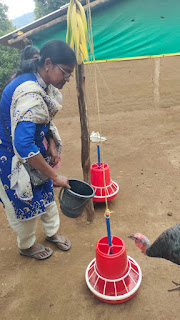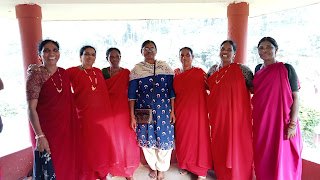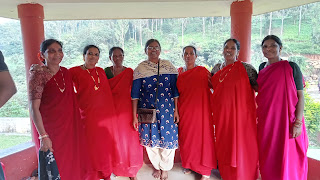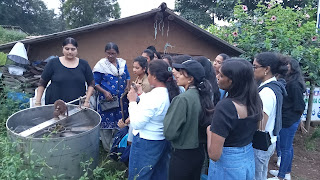Field trip
Faculty
Coordinators- Dr P. Mary Anupama, Head, Dept of Biochemistry , with Mr Rajesh and Mr
Anand, Technicians of SJCW
REPORT
About RySS
Vide G.O.Ms No. 197
Finance (R&E) Department dated 04 October 2014 issued by State of Andhra
Pradesh, Rythu Sadhikara Samstha has been established as a not-for-profit
company under Section 8 of the Companies Act 2013 to create integrated
institutional mechanism for all programmes, schemes and activities intended for
farmer’s empowerment, encompassing welfare, development, capacity enhancement,
credit flow, financial support and allied empowerment activities. Rythu
Sadhikara Samstha in English can be read as Farmer Empowerment Organisation.
Andhra Pradesh Community
Managed Natural Farming (APCNF) is being implemented by Rythu Sadhikara Samstha
as per GO RT No. 764, dated 10-11-2016.
Genesis of the A.P
programme. In 2016, the Agriculture Dept., Govt of A.P initiated the programme
that was called ‘A.P Zero budget natural farming’. This programme builds on an
earlier programme of the State Govt’s Rural Development Dept , called A.P Community
Managed Sustainable Agriculture. This was under implementation from 2004 to
2014. This precursor programme was a
State wide programme, covering both A.P and Telangana States. And, it was taken
up through the Women S.H.G s. Initially it focused on non chemical pest
management, and in later years there were interventions around soil health
improvement and water conservation.
The present context. As a
society, we are facing multiple emergencies. Farmers livelihoods are under
severe stress. Young people are migrating from rural areas to urban areas,
often for low paid jobs, as they do not see much future in agriculture livelihoods.
On the other hand the food we are eating is not safe and it is not as
nutritious as it used to be in the past. We have a huge crisis on the soil
front as we have lost vast amounts soil organic matter and we continue to lose
soil organic matter at a rapid pace. There is a severe water stress. There is
very widespread loss of biodiversity. All these are going to exacerbate further
on account of global warming.
Why Natural farming ? It
is in response to these multiple crises that the Govt of Andhra Pradesh turned
to Natural farming, as a way of solving these multiple crises. The Govt wants
to enhance farmers’ net incomes by reducing their costs of cultivation, improving
their yields, reducing their risks and enabling them to get remunerative
prices. We believe very strongly that these can be delivered through farming in
harmony with nature, and not through use of high cost synthetic fertilisers,
pesticides, herbicides and weedicides. Govt also believes that the nutritional
integrity of the food should be enhanced and food should be free from chemical
residues. Further, Govt is very concerned about the risks to Agriculture
because of the loss of soil organic matter, water stress and the worsening
climate change crisis. Hence, in addition to the interests of the farmers and
the consumers, the Govt has adopted Natural farming as it is environment
friendly. It enhances climate change resilience. It enhances soil organic
matter, soil fertility, water holding capacity of soils, and enhances bio
diversity (above ground and below ground).
A.P.C.N.F – primacy to
farmers own practices. In 2020, the name of the programme was changed to A.P
Community managed natural farming, to emphasize farmers’ ownership. Even when
the programme was called A.P Zero budget natural farming programme, our farmers
were following a mix of Z.B.N.F practices and other biological and non-chemical
inputs : farm yard manure, vermi compost, NADEP compost, dung from buffaloes,
using inoculants like VAM, PSB, etc. We respect farmers’ choices in the matter
of practices. We regard all of them as NF farmers, as long as they are not
using synthetic chemical fertilisers, pesticides, herbicides, weedicides. In
addition, we have 34 N.G.O partners and they have their own variations. We have
adopted all these variations. The change in name from APZBNF to A.P Community
managed natural farming (A.P.C.N.F) is to give explicit recognition to the fact
that the programme is farmer centric, follows farmer to farmer extension system
and is driven by their innovations.
1.
Redsandal wood - Pterocarpus santalinus
2.
Ashok - Saraca indica
3.
Spathodia - African Tolip tree
4.
Silver oak - Greyillearobusta
5.
Pepper - Pepper nigram
6.
Pineapple - Bromeliaceae
7.
Adenium- Obe (sum)
8.
Acalypha - Hispida
9.
Heliconia- Lanceana
10.
Dracbena- nireinata
There are four wheels of
farming
1. Seed treatment
2. Addition of
Jeevamrutham, Drava Jeevamrutham and
Ghana geevamrutham
3. Mulching
4. Vapasa
1. Seed treatment - This
is done with *Jeevamrutham*
Ingredients
1.
5 L of cow urine
2.
5. Kg of cow dung
3.
20 L of water
4.
50 grams of Lime
Procedure
-
Mix all the above ingredients
-
Place cow dung in a cloth and immerse in the liquid
-
leave it over night for fermentation to take place
-
squeeze cow dung and remove it.
-
sprinkle the above on seeds to be sown. This will enable germination of 80% of
seeds
-
leave seeds in shade for 2-3 hours
-
Now the seeds are ready to be sown
- Validity of the
preparation is for 24 hours only, hence prepared as per the quantity of seeds
Advantage -
1.
Contributes to pest resistance and viral resistance
2.
Can be used for germinated seedlings too if seeds are not treated
3.
Any malformed seeds if present they will also grow
Application - can be used
for rice, tubers, root based plants and any seeds
Drava Jeevamrutham
Ingredients
-
1.
200 L water
2.
2Kg of Jaggery
3.
2Kg of Besan
4. 10Kg cow dung
5.
20L cow urine
Procedure
-
-
Take 20L of urine and mix with Jaggery and Besan
-
Mix it thoroughly and add cow dung
-
Mix it clock wise and cover it with gunny bag. This enables stirring of
ingredients and as it is an aerobic fermentation that is taking place allows
exchange of gases
-
Leave it for 3 days with intermittent mixing
Application
-
-
Can be sprayed to plants or to seeds
-
contributes to better growth of plants
*Ghana Jeevamrutham*
Ingredients
-
1.
200 Kg cow dung
2.
2 Kg jaggery.
3.
2 Kg besan
4.
Cow urine - as per texture of dung. If dry more urine has to be added, if dung
is fresh there is no need to add much cow urine
5. Mud from Ant hill - it
is prepared from soil collected from ants and has good microbes from the mouth
of ants that contribute to attracting microflora of soil that can contribute to
mineral availability in the rhizosphere of plants
Procedure
-
-
Mix all the ingredients uniformly
-
make them into balls of uniform size
-
Dry the balls in shade ( to prevent death of useful microbes ).
-
Leave them untill they dry ( this is like solid state fermentation)
-
Make them into powder and sprinkle it near the roots of the plants or to the
sown seeds
Pest
management strategies - This is called Non- pest management
This
includes usage of leaves from 5 different types of plants which are boiled in
cow urine
1.
Neem Asthra - prepared from neem leaves - effective upto egg and larval stage
of pests
2.
Brahmastra - 5 types of leaves are used - used to prevent adult stages of pests
Leaves
used are 5 leaves that not grazed by sheep or goats , which include - leaves
from custard apple, neem , Castor, Papaya and Pardanda .
These
leaves are chopped and added to boiling urine.
They
are boiled until the entire volume comes to half
1Kg
if all leaves are added except Neem leaves which is added more 2 Kg quantity
Boiling
is followed by cooling for 2-3 days and then filtered
This
can be stored for little longer time
At
times chilli paste and garlic can also be added which is very effect as the
larvae die after eating the leaves of plants sprayed by this liquid
Raithu
saadhikara samstha encourages 5 layers of farming. This is also called as
integrated farming system
Shri
Sri Ram sir , the HR manager explained about this.
The
farmers in agencies need to work on this and to sustain through out the year
and to generate income the villagers are taught this
Paddy
is grown by the farmers generally by line method . In this method, the paddy is
grown in lines at right angles to water flow
This
allows good water utilisation.
But
the plan works only during seasonal rains and water is abundant
.there
is also Sri Daddy method in which good spacing is given between each plant and
there are equally spaced and placed . This is if use when drip irrigation
facilities are available or when water is available through out the year
When
a space is given the plants to be added are spaced and placed based their
levels
Layer
1 Coconut trees. These are tall ones
Later
2&3 - comprises of medium sized plants like guava, custard apple, sapota
etc.
4
th level Comprises of vegetable plants
5th
level comprises of tubers
These 5 levels of plants
are carefully planned in an integrated management system
So
during good season the farmers plan and plant the land
As
vegetables are seasonal, to generate income during that time, poultry, fishery
and animal husbandry is encouraged
:
Sri Ram sir explained the POP s for paddy
1.
Seedling told are cut and immersed in water to prevent laying of eggs by
insects. These cut tips are to be kept in soil or immersed in water. They must
never be left floating as they can I cute pests to lay eggs
2.
Addition of Jeevamrutham and Bejamrutham based on need
3.
Line sowing of seedlings
4.
Placing yellow sticky traps. These will stick insects. Yellow color attracts
the insects hence they stick. Based on the types of insects stuck and their
count appropriate pest management method is suggested
5.
Pheromone traps can also be used. pheromone is a aromatic compound that
attracts female insects . They enter the trap and get captured in a polythene
cover. So reduction in female population will reduce overall pest population
6.
After harvesting of paddy, cows are left in field to graze. This adds useful
microbes from cow saliva to soil
7.
Addition of cultivated azolla is recommended. Azolla is a nitrogen fixing blue
green algae
Epiculture-
Cultivation
of bees for getting honey and bee wax is called epiculture-
The
bees exist as colonies. They are grown in bee boxes. Each bee box has 50000 to
70000 bees.
Bees
are of various types -
Every
bee hive or bee box has one queen bee whose life span is 2 years. There will be
40-50 male bees whose life span is around 40 days. They die soon after mating. Single
queen bee lays 1500 eggs per day and
each egg is kept in a single cell of bee hive.
Within
15 days the egg Transformes into an adult bee. Next important population are
the worker bees. Each corner bee collects atleast one spoon full if honey
during it's life time. They collect pollen from plants, eat it, convert to
honey, and produce wax. This wax is used to make the hexagonal cells of bee
hive . The workers life span is also less
In epiculture, rectangular plates with two
wires are used. This divides the plates into 3 compartments. The bees start
making wax cells and store honey . Once the plate of full the honey is
harvested by spinning the plates in a vessel as shown in the figure. The honey
drops down and the plates are placed back in racks.
This
is done two or three times untill the wax is turning brown . The wax is sold
for usage in beauty products. The smell or flavor that honey has is based upon the flowers available in that
season.



















.jpg)





































































































0 Comentarios